 |
 |
 |
| |
Hepatitis C Viremia following Sustained Virological Response to Pegylated Interferon and Ribavarin in HIV+ Men Who Have Sex with Men-Re-infection or Late Relapse?
|
| |
| |
Reported by Jules Levin
15th CROI, Feb 2008, Boston
Rachael Jones*1, D Brown2, M Nelson1, S Bhagani2, M Atkins1, M Danta3, G Dusheiko2, O Pybus4, and D Asboe1
1Chelsea and Westminster NHS Fndn Trust, London, UK; 2Royal Free and Univ Coll Med Sch, London, UK; 3Univ of New South Wales, Sydney, Australia; and 4Oxford Univ, UK
From Jules Levin: this study was reported at CROI in the oral HCV session. They report from London that coinfected patients who were treated during acute HCV infection with Peg/RBV who achieved SVR subsequently were found to have HCV viremia. The viremia was not suspected to be relapse but REINFECTION by sexual behavior years after achieving SVR. It has been I think well established in the world of HCV monoinfection that after achieving SVR a patient is NOT protected from reinfection if they expose themselves to HCV again. But in HIV researchers like to re-study the same question looked at in HCV monoinfection again in coinfection, and I think always get the same answer. I think the main and important messages from this tudy are: (1) in Europe sexual transmission of HCV among HIV-infected individuals has been found and reported at conferences for several years now. (2) similar research in THE USA has not been conducted. (3) these study authors report that these 16 patients had STIs suggesting this facilitated reinfection, which I certainly think is a likely scenario; studies have reported the presence of an STI in an HIV+ individual can facilitate HCV sexual transmission. (4) there has been apparently little education to patients that they can get reinfected after achieving an SVR OR they were educated to this but forgot or ignored it. (5) these series of studies out of Europe provide I think strong evidence that HCV/HIV coinfection is sexually transmissible and that increasing rates acute HCV infection among MSM is occurring and a serious concern. (6) what we are not looking at, is sexual transmission among coinfected heterosexuals occurring but we are not looking for it and therefore overlooking a problem. (7) finally and in clonclusion, sexual transmission of HCV is I think a serious and real concern that is NOT being adequately addressed. Although a number of USA docs/researchers are not convinced that this is occurring.
Progtram Abstract
Background: The rise in the incidence of acute hepatitis C virus (HCV) infection in HIV+ men who have sex with men (MSM) has been well documented. Where individuals clear HCV, associated immunological responses do not provide complete protection from HCV re-infection. We report a group of acutely co-infected MSM who presented with HC viraemia after sustained virological response (SVR) following initial infection. We hypothesised that HC viremia subsequent to SVR was likely to be due to re-infection, following further sexual exposure, rather than late relapse.
Methods: Databases at both Chelsea and Westminster and Royal Free Hospitals were interrogated to reveal individuals with confirmed HC viremia following SVR to initial HCV infection. SVR was defined as undetectable HCV polymerase chain reaction (PCR) for >6 months either in those who spontaneously cleared infection or following completion of pegylated interferon (PEG-IFN)/ribavarin (RBV). Viral RNA was extracted from paired stored sera. The E1/E2 region, including HVR-1, was amplified by RT-PCR and sequenced. Using PAUP software, a phylogenetic tree was constructed from the paired sequences, facilitating genotypic comparison between the patients' viruses and unrelated Genebank E1/E2 sequences. Sexually transmitted infection diagnoses during the HCV SVR period were recorded.
Results: Of 211 co-infected individuals, 16 had ≥2 episodes of HCV infection, the second episode detected following an elevation of alanine aminotransferase (ALT). All were MSM, mean length of HIV infection was 4 years (1 to 17), with a mean age at first HCV infection of 38 years (26 to 51). Mean length of SVR was 20 months (6 to 36); 11 were on HAART and all 16 received PEG-IFN/RBV following their first infection. From 8 individuals, we obtained paired samples that were amplifiable. Phylogenetic analysis revealed 2 individuals with closely related sequences indicative of late relapse. The remaining 6 had divergent, paired sequences likely to represent re-infection with a different strain. HCV genotypes seen in these 6 were the same as the initial infection. All but 2 individuals had ≥1 concurrent sexually transmitted infection during the period of SVR, syphilis being the modal infection.
Conclusions: Of 8 individuals, 6 who had further HC viremia following SVR, were re-infected with a different HCV strain. Re-infections were likely related to ongoing high-risk sexual activity. The clustering seen indicates that this is a relatively closed population, exchanging HCV within the cohort. In 2 cases, the strains were closely related indicating either late relapse or possibly re-infection from a common source.
CROI Poster 1066
HCV Spreads among HIV+ Men Who Have Sex with Men: Evidence of Separate Sexual Transmission Networks in Europe and Australia
Thijs van de Laar*1, M Danta2,3, S Bhagani2, M L Chaix4, G Dore3, M Nelson5, M Prins1,6, M Vogel7, P White3, R Coutinho1,6,8, and HIV and Acute HCV group
1Hlth Svc, Amsterdam, The Netherlands; 2Royal Free and Univ Coll London, UK; 3Univ of New South Wales, Sydney, Australia; 4Hosp Necker, Paris France; 5Chelsea and Westminster Hosp, London, UK; 6Academic Med Ctr, Amsterdam, The Netherlands; 7Univ of Bonn, Germany; and 8Natl Inst of Publ Hlth and the Environment, The Netherlands
Program abstract
Background: Rising hepatitis C virus (HCV) incidence rates among HIV+ men who have sex with men (MSM) in Europe have been reported since 2000, and are associated with high-risk sexual behavior. To investigate whether sexual transmission of HCV among HIV+ MSM is restricted to small city-bound outbreaks or whether a large-scale European sexual HCV transmission network exists, a phylogenetic study was conducted.
Methods: We enrolled 224 HIV+ MSM diagnosed with acute HCV infection from England (n = 107), the Netherlands (n = 58), Germany (n = 24), France (n = 11), and Australia (n = 24). Part of the HCV NS5B region (436 bp) was amplified and sequenced. Maximum likelihood phylogenies were constructed using PAUP* (HKY-_ substitution model), comparing MSM cases with unrelated NS5B sequences. Date of origin for each MSM-specific HCV cluster will be estimated using a molecular clock approach.
Results: In total, 200 (89%) of 224 NS5B sequences were obtained. Circulating HCV strains were of subtype 1a (60%), 4d (23%), 3a (10%), 1b (5%), and 2b/c (3%). Phylogenetic analysis revealed 12 distinct MSM-specific HCV clusters of mainly subtype 1a and 4d, containing 3 to 37 sequences each (bootstrap values >70%) covering 160 (80%) of the sequences. Of 6 larger clusters, 5 (>10 sequences), contain sequences from more than 1 European country. In contrast, country-specific clusters tend to be smaller (<10 sequences) or are Australian. Despite a high degree of clustering within the continents of Europe and Australia, mixing between both continents was seldom observed.
Conclusions: Current phylogenetic analysis reveals 2 recently evolved networks of ongoing HCV transmission among HIV+ MSM, one in Europe, presumably linked to traveling associated with sexual high-risk behavior, and a separate one in Australia. Co-circulating HCV lineages of different genotypes suggest (behavioral) change of the host rather than intrinsic viral evolution of the virus itself. International mixing of sequences increases with cluster size emphasizing the rapid spread of regional outbreaks to neighboring countries. Targeted prevention and implementation of frequent HCV screening in HIV+ MSM is needed to deter further spread of this emerging sexually transmitted infection, especially because 90% of HIV/HCV-co-infected MSM harbor strains of difficult-to-treat HCV genotypes 1 and 4.
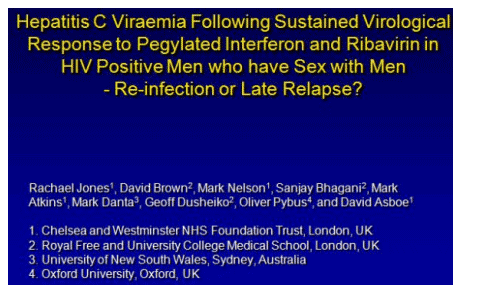
The idea that once HCV is cured that it a person can be reinfected by a subsequent exposure is fairly well documented in the world of HCV monoinfection, and I don't think there is a need to re-establish that this can occur in HIV as well, but alas here is another coinfection study repeating the same finding.
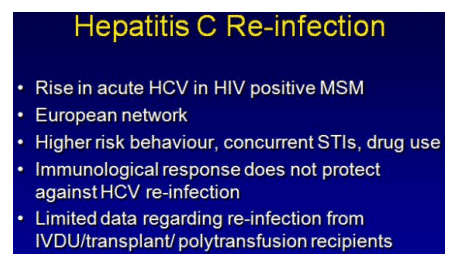
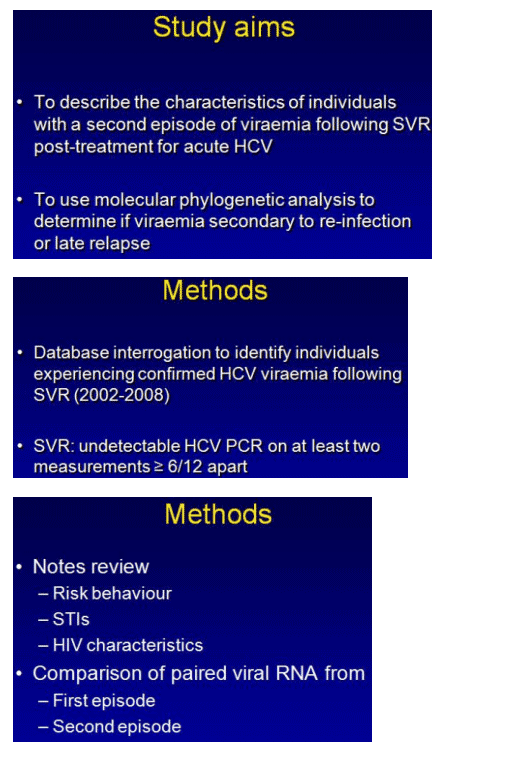
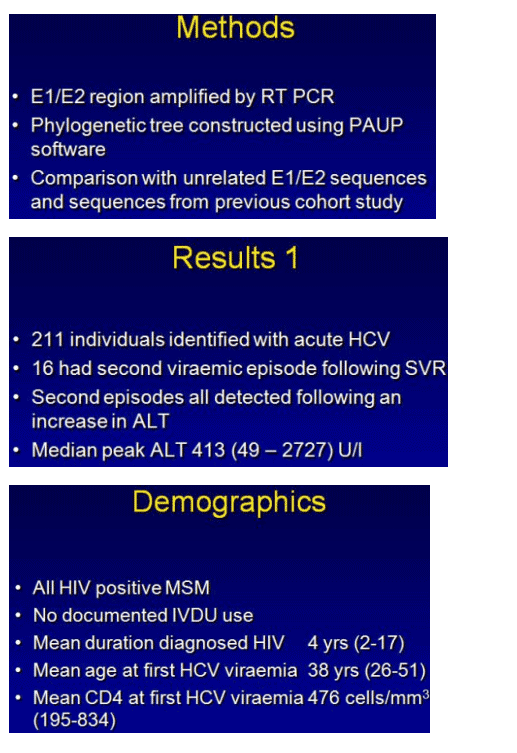
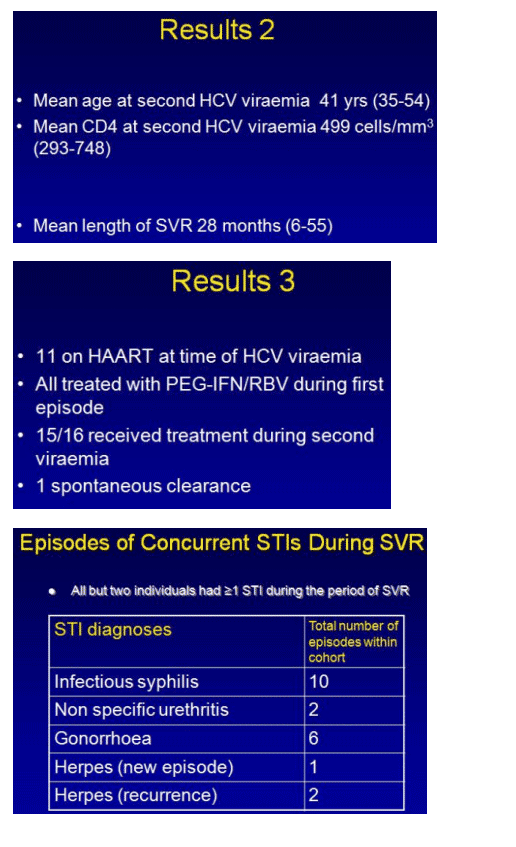
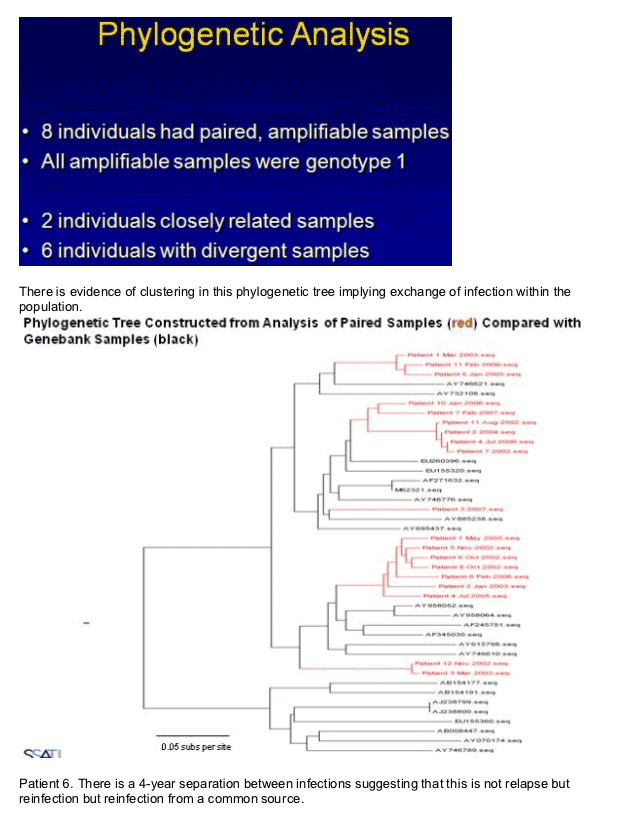
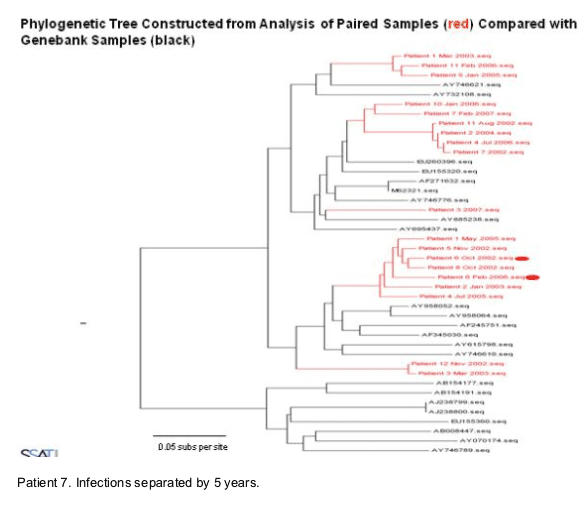
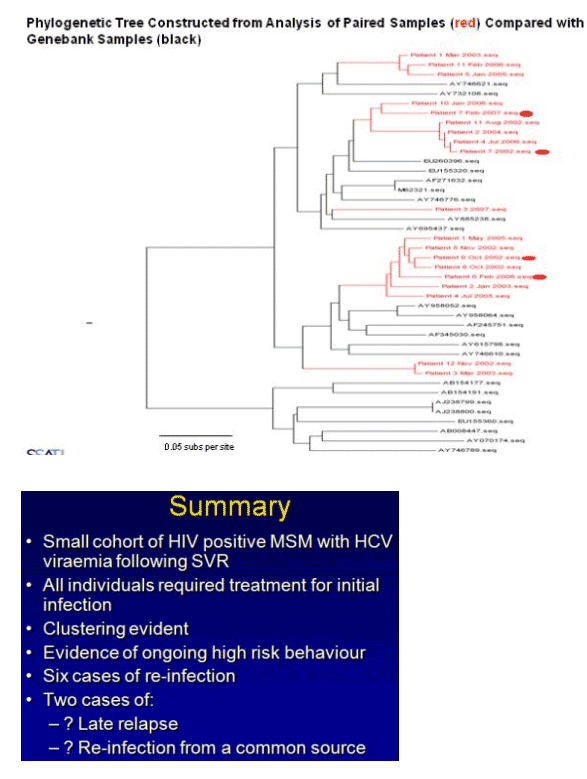
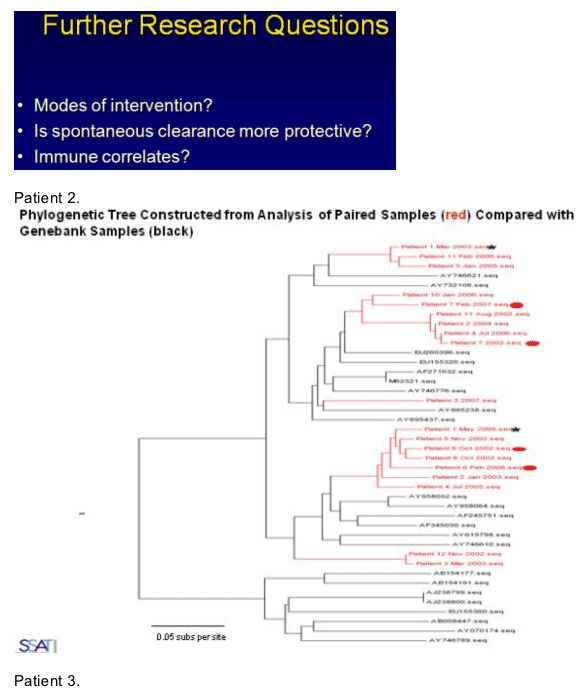
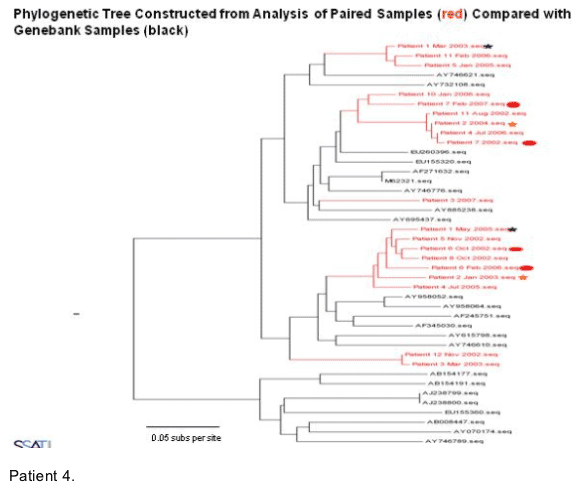
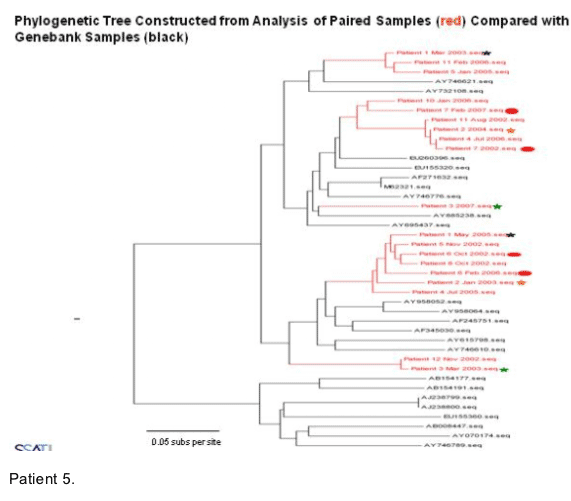
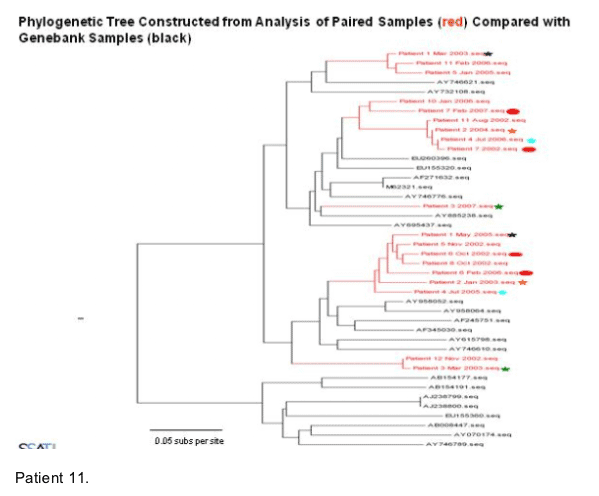
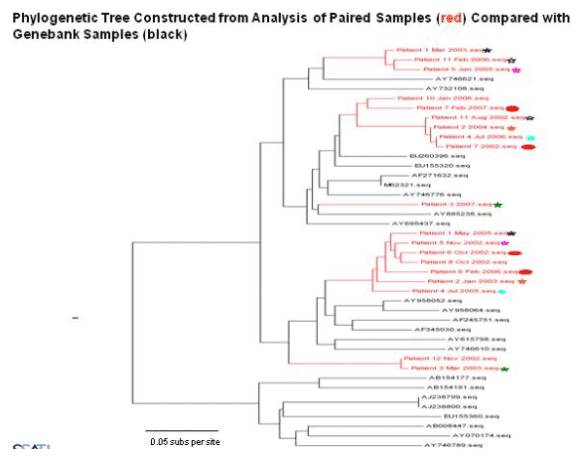
|
| |
|
 |
 |
|
|